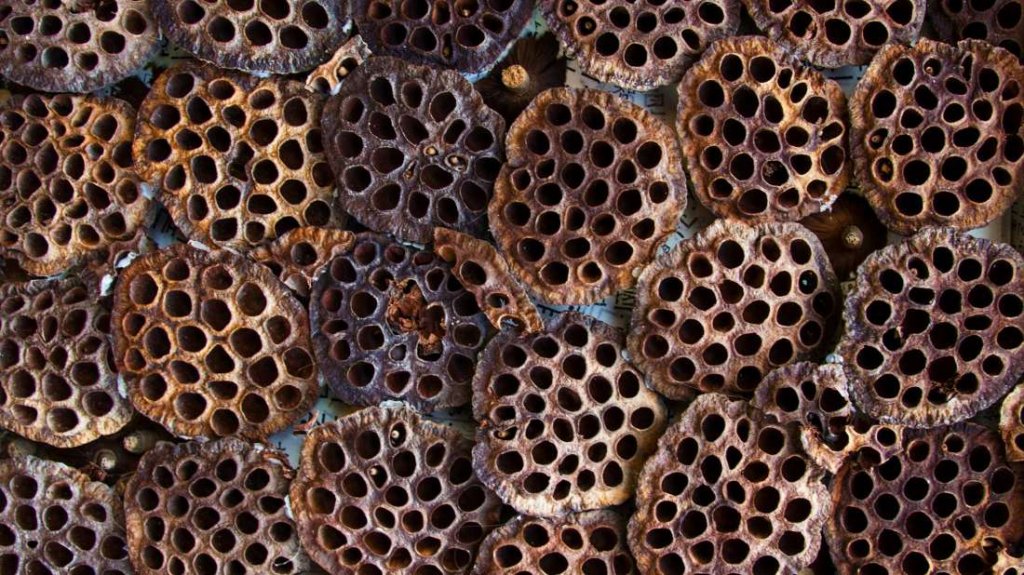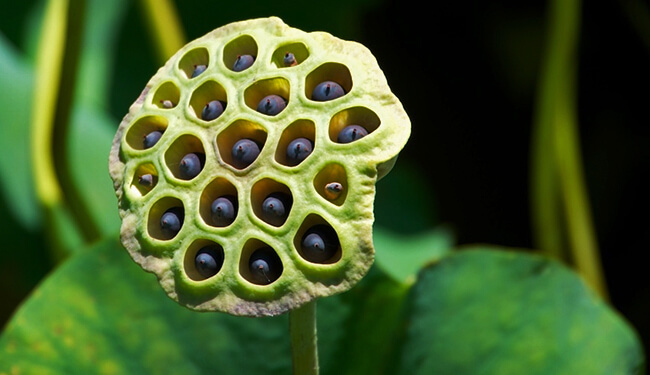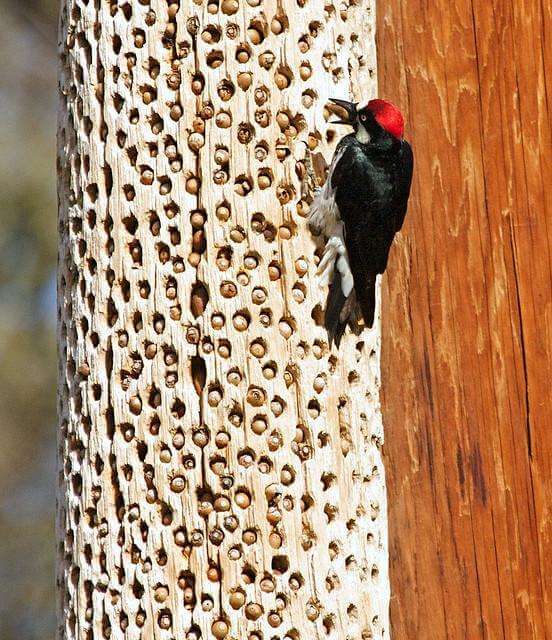Trypophobia is the fear of clusters of holes or irregular patterns or bumps. Some people feel extremely uncomfortable when they see these patterns. It makes them feel like something is crawling up on their body, tingling sensation through the body. It is not officially considered as a mental disorder, and rather it is just a feeling of discomfort when one comes in contact with certain patterns. Trypophobia is a word derived from the Greek language where “Trypa” means holes and “Phobos” means fear. Hence Trypophobia, in layman’s language can be termed as fear of holes or phobia of holes. Experts claim it to be a learned behavior.

The table below shows the Trypophobics population
| Particulars | Trypophobics percentage |
| Men | 11% |
| Women | 18% |
| General | 15% |
Table of Contents
Causes of Trypophobia:
Trypophobia comes either with genes or it can be a learned behavior. It is more of a feeling of disgust than fear. Trypophobics can’t stand to look at the images of lotus pod, honeycomb, strawberries, and a cluster of soap bubbles. The actual fear of this started when photoshopped pictures like this started rolling on the internet. These are not real images; they are created only to cause terror in Trypophobics.
There are some other factors that could cause the phobia of holes:
- Human DNA
Some psychiatrists consider trypophobia could be due to the DNA i.e. it could have passed on to an individual through hereditary. It’s in their blood to feel repelled towards certain patterns.
- A sense of danger
These tiny clusters of holes resemble various diseased body parts ridden with diseases like chicken pox, smallpox, skin blisters, measles, and rubella. Along with that several ectoparasites like scabies, ticks, and botfly lead to these kinds of patterns. Trypophobics brain associates the tiny cluster of holes with danger. They feel that they will be infested by these parasites and it will lead to those patterns on their body which provoke disgust in them
- A traumatic past experience
Some might respond this way due to deeply rooted emotional trauma that they have faced. At times people who have suffered through some skin disease that have formed these hole clusters on their body or if they have seen someone suffering from a similar disease. The clusters of holes act as a cue to the infectious disease and they tend to react with panic or feel nauseated when they see such images.
- Excessive Brain Oxygenation
Trypophobics experience some emotional triggers. This is due to the energy their brain uses when looking at the visuals. Our brain uses around 20% of our body’s energy. This excessive use of energy by the brain causes discomfort, headache or eye strain. So, they avoid looking at the image that pressurizes their brain.
The Phobia of holes is not limited to images; some individuals may also fear the holes on the skin, meat, on fruits and vegetables, wood, honeycombs etc. for some individuals even the verbal mention of the “fear of cluster of holes” is enough to trigger repulsive response. There are also people who think there are some harmful organisms living inside those holes which would come out and cause an infestation.
Symptoms of Trypophobia:
Phobia of holes is in all of us. Every one of us gets disgusted when we come across certain images of diseases. What matters are the subtle or intense reactions we give to those images? Trypophobics can’t even look at the images; they either turn their head away or look by closing their eyes halfway.
- Goosebumps
- A sensation of bugs crawling on skin
- Panic attack and anxiety
- Excessive sweating and dizziness
- Trembling hands
- Feeling itchy
- Restlessness or discomfort
- Visual discomforts like eye distortions, eye strain or illusion
- Repulsion
- Nausea
- Rapid heart rate
- Heat or cold flashes
- The uneasy feeling in stomach
- Thoughts of death
- Feeling suffocated
Fear of holes test:
Fear of holes in intense cases must be diagnosed by a licensed psychiatrist. The doctor would, first of all, ask a series of questions to find out how intense the phobia is. The doctor would also ask about social, medical and psychiatry history. But, Trypophobia is not a disease but just a mental condition. So, diagnosing it takes more than just questions.
- Lotus seed pod phobia test

The phobic will be exposed to an image of lotus seed pod. If the image triggers any kind of disgusting response, then Trypophobia will be affirmed.
- Trypophobia test
This test is conducted by exposing the phobic to some other patterns and pictures to observe the response. It includes images of lotus pods photoshopped on the skin, corals, bubble cluster, barnacles. The worst case of Trypophobia is when even the bubbles formed on coffee or milk.

Going through these tests can help one understand the depth of their phobia and its impact on their life. It may take a specific amount of time to cure depending on how deeply they have rooted.
Trypophobia Cure:
It should be noted that the treatment for trypophobia depends upon the intensity of the phobia. The medical science is still doubtful about the occurrence of this phobia. So those tests that are used in the treatment of other phobias will be used to treat fear of holes.
- Cognitive Behavior Therapy
Unlike other therapies where the therapists try to identify the unconscious causes, Cognitive behavior therapy is “problem focused” and “action-oriented”. It is a short-term therapy that takes a practical approach to treating the phobia. The therapy aims at changing the patterns of thinking and also the behavior that acts behind the phobia. It includes conversion of negative, unproductive and harmful thoughts into positive ones. Gradually it helps the Trypophobic to differentiate between the reality and his imagination.
- Exposure therapy
This is a therapy where the phobic is exposed to various patterns and structured clusters of holes. The repulsive acts of the phobic are controlled and his brain is trained to look at those images. This therapy lessens the obsession oh the Trypophobic.
- Morita therapy
Morita therapy is influenced by the psychological principles of Zen Buddhism. This theory adopts the concept “go with the flow”. The ultimate goal of this therapy is to build the character of the patient to enable him to live responsibly and patiently.
- Hypnosis therapy
This therapy is an effective therapy for curing phobia. Here, the cause of phobia is recovered by eliminating the affected person’s response to stimuli. The goal of this theory is to find out the root of the phobia. To access this root cause, the patient needs to achieve a state of trance that is a heightened state of relaxation. Sometimes the patients himself will not be able to recover the cause of his phobia. By going to the phase of trance the unconscious memories can be revealed and brought to conscious awareness. When this is achieved, Trypophobia will disappear.
- Counseling
Counseling is a very common method used by psychiatrists to treat any mental disorder. The therapist asks a series of various questions to the patient. These questions include an overall insight into the phobia. By the end of the counseling session, the root of the fear of holes is found out and the solution for it is given.
- Behavior therapy
A trypophobic undergoing this therapy is made to control their unwanted behavior. This therapy helps them to cope with difficult situations i.e when they are exposed to tiny clusters of holes.
- Neuro-linguistic programming therapy
This therapy includes exposing the patient to images of clusters of holes and altering or reprogramming them in order to reduce the phobia.
- Havening- a new way to cure Trypophobia
Havening is a revolutionary therapy developed by genius medical doctor Dr. Ronald Ruden from New York. It is a very simple, yet strikingly effective process. In this therapy, there is a combination touch and therapeutic patterns like counting and humming in a very explicit way that facilitates clients to dive right into many phobias. Havening actually aims at delinking the memory from its phobia by first focusing on getting rid of phobia of holes and subsequently giving strong impulses to the brain that will de-link the symptomatic reaction.
This therapy is has a Havening Touch. It is a process where the head or the arms are being touched in a way to trigger the immediate release of “feeling well hormones”. This creates immediate and lasting change.
- Medication
Taking certain medicines prescribed by the doctor will help in controlling anxiety and panic attacks caused by the phobia
- Yoga, meditation and relaxation techniques
If the fear of holes is too severe that you feel strongly repulsive just at the sight of the object, using different relaxation techniques can be helpful to reduce anxiety. Yoga and meditation, progressive muscle relaxation, proper breathing exercise or a long bubble bath can give great relaxation to mind. You can try your own best ways to relax and help you deal with your triggers.
- Change in Lifestyle
Trypophobia in severe cases affects routine activities. So making small changes in your lifestyle can bring a huge benefit to your anxiety. Taking a walk, following a healthy diet containing fruits, vegetables, lean protein and whole grains, 7-9 hours of sleep can regulate your anxiety under control.
- Self-help groups
Trypophobics should become a part of self-help groups where they could meet other people dealing with the same and try to help each other build confidence and overcome their obsession.
- Sharing with family and friends
People dealing with anxiety disorders like Trypophobia need to maintain trustworthy friends and close contacts with family. They need to share their triggering problems with family and best friends who can accept them and help them overcome their fears. If that is still too much, they can even join some online forums where one can discuss the problems with many experts. There are even chances to meet other trypophobics who are dealing or have overcome the phobia. They may suggest different methods they have used to overcome.
- Treat yourself
Some trypophobics who are not that repulsive yet feel awkward looking at a cluster of holes do not need any medical treatment. They can treat themselves. Whenever they come across such images or patterns all they have to do is look up for images of some fluffy kittens or puppies, watch cute baby videos, listen to some soothing music just so they can get their mind off those gross pictures.
The level of existence of trypophobia is not known. But the repulsion to trypophobic images is common. Many people find it loathing to look at those grotesque images. What matters is the complexity of the fear of holes that one is dealing with. So, whenever you come across your fear of holes remember they are just photoshopped pictures with lotus pod or some natural phenomenon of corals, barnacles or honeycomb and they cannot cause any harm.




























